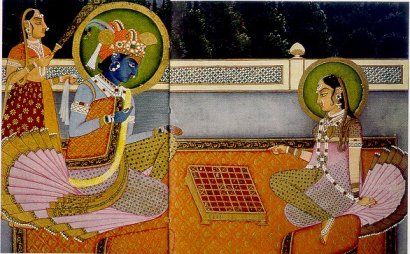27 The legend of Ambalapuzha
Exponential growth is a powerful concept. To help us grasp it better let’s use an ancient Indian chess legend as an example.
Learning outcomes:
- Use of Excel formulae for mathematical modeling.
- Understanding the multiplicative process of exponential/geometric growth.

According to legend, Lord Krishna once appeared in the form of a wise man in the court of the king and challenged him to a game of chess. The king was a chess enthusiast and naturally accepted the invitation.
The king asked the wise man to choose a prize in case he won. The old man told the king that he had few material needs and that all he wished was a few grains of rice.
He added that the amount of rice itself should be determined using the chess- board in the following manner: one grain of rice would be placed in the first square, two grains in the second square, four in the third square, and so on. Every square would have double the number of grains of its predecessor.
Upon hearing this, the king was unhappy, since the man requested only a few grains of rice instead of any of the other riches of the kingdom, which the king would have been happy to donate (he was a generous guy). He requested the old man to add other items to his prize, but the man declined.
So the game of chess started and, needless to say, the king lost the game so it was soon time to pay the old man his prize. As he started adding grains of rice to the chessboard, the king soon realised the true nature of the wise man’s demand. The royal granary soon ran out of rice and the king realised that even if he provided all the rice in his kingdom and even the whole of India, he would never be able to fulfill the promised reward. He was distraught that he could not fulfill his promise!
Seeing the king upset, the wise man appeared to the king in his true form, that of Lord Krishna. He told the king that he did not have to pay the debt immediately but could pay him over time. The king would serve rice in the temple freely to the pilgrims every day until the debt was paid off. And that is why the Ambalappuzha Temple in India still serves rice to pilgrims – the debt is still being paid off.
Use the Excel sheet ([RiceOnAChessboard.xlsx](https://www.dropbox.com/s/nf81t0hzz34vyzk/RiceOnAChessboard.xlsx?dl=1)) to calculate the quantity of rice that the king owed.
A grain of rice weighs 25mg, what weight of rice did the king owe in total, in kg?
27.1 Animals/plants, not grains of rice.
Imagine that instead of rice, we were talking about the population growth of bacteria, or rabbits, reproducing every time step.
- Would the model be realistic?
- Why/why not?
- What other factors should be taken into account?
27.2 Optional: Try these calculations in R
You can do this kind of calculation easily in R. Try this.
myData <- data.frame(Squares = 1:64,nRice = NA)
myData$nRice[1] <- 1
for (i in 2:64){
myData$nRice[i] <- myData$nRice[i-1]*2
}Now we can look at the top and bottom of the 64 row data frame like this:
## Squares nRice
## 1 1 1
## 2 2 2
## 3 3 4
## 4 4 8
## 5 5 16
## 6 6 32## Squares nRice
## 59 59 2.882304e+17
## 60 60 5.764608e+17
## 61 61 1.152922e+18
## 62 62 2.305843e+18
## 63 63 4.611686e+18
## 64 64 9.223372e+18And we can sum up the total number of grains of rice on the 64 squares of the board like this:
## [1] 1.844674e+19To put that HUGE number in context, if a grain of rice ways 25mg (0.0000025kg), then we’d have 46,116,860,184,274 kg.